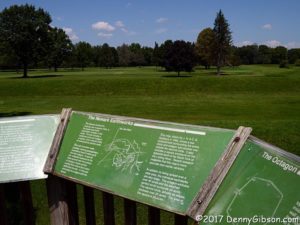 It’s not really a house and it’s never actually closed but an “open house” is what the Ohio History Connection calls each of the four days a year that tours are conducted and the general public is permitted inside Octagon Mound at Newark, Ohio. On all other days, access is restricted to members and guests of Moundbuilders Country Club who has leased the property since 1910. While that may sound disrespectful or even sacrilegious, the arrangement has provided a degree of protection that not all area mounds have received. Octagon Mound is part of the largest group of geometric mounds in the world. In addition to the octagon and an attached circle, Newark Earthworks once included a larger circle, a square, and an ellipse along with several pairs of long mounds connecting the geometric figures. The ellipse and all but a fragment of the square have been obliterated and covered over by the city of Newark. Just over forty miles to the southwest, a huge circle mound that gave the city of Circleville its name has been destroyed and buried under that city. In comparison, maybe having a few golfers wandering around isn’t so bad.
It’s not really a house and it’s never actually closed but an “open house” is what the Ohio History Connection calls each of the four days a year that tours are conducted and the general public is permitted inside Octagon Mound at Newark, Ohio. On all other days, access is restricted to members and guests of Moundbuilders Country Club who has leased the property since 1910. While that may sound disrespectful or even sacrilegious, the arrangement has provided a degree of protection that not all area mounds have received. Octagon Mound is part of the largest group of geometric mounds in the world. In addition to the octagon and an attached circle, Newark Earthworks once included a larger circle, a square, and an ellipse along with several pairs of long mounds connecting the geometric figures. The ellipse and all but a fragment of the square have been obliterated and covered over by the city of Newark. Just over forty miles to the southwest, a huge circle mound that gave the city of Circleville its name has been destroyed and buried under that city. In comparison, maybe having a few golfers wandering around isn’t so bad.
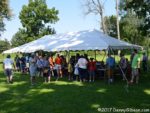
 Last Monday, July 31, was an Open House day with hourly tours starting at noon. I was there in time for the first one but, after listening to the guides pre-tour comments, I stayed behind when the group headed off to enter the enclosure. The group seemed overly large to me and I thought I might do better with a later tour.
Last Monday, July 31, was an Open House day with hourly tours starting at noon. I was there in time for the first one but, after listening to the guides pre-tour comments, I stayed behind when the group headed off to enter the enclosure. The group seemed overly large to me and I thought I might do better with a later tour.


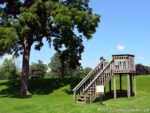 Instead I took the opportunity to look at the map the guide had referenced as he spoke then walked to a nearby observation platform. The platform allows the public to peek inside the enclosure even on days when they are not permitted inside. The picture at the top of this post was also taken from the platform. A path that runs part way around the attached circle is also always available to all and I traveled it while awaiting the next tour. A feature of the circle opposite its connection to the octagon stands several feet higher than the circle itself and has been given the name Observatory Mound. The path leads to within sight of Observatory Mound but doesn’t quite reach it. Walking beyond the path is permitted today and I continued on to the raised section.
Instead I took the opportunity to look at the map the guide had referenced as he spoke then walked to a nearby observation platform. The platform allows the public to peek inside the enclosure even on days when they are not permitted inside. The picture at the top of this post was also taken from the platform. A path that runs part way around the attached circle is also always available to all and I traveled it while awaiting the next tour. A feature of the circle opposite its connection to the octagon stands several feet higher than the circle itself and has been given the name Observatory Mound. The path leads to within sight of Observatory Mound but doesn’t quite reach it. Walking beyond the path is permitted today and I continued on to the raised section.
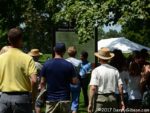
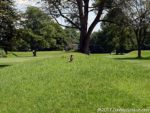
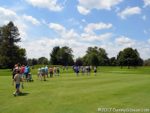 The second tour contained nearly as many people as the first so I didn’t help myself much by waiting. I did stick with this one, however. As we paused at the opening to the interior, the guide pointed out that the approximately five foot tall mounds were at an almost ideal height for an adult human to use as sighting lines. Of course, as you can see, smaller creatures can sight along them as well if they position themselves properly. Following an overview of where we were and where we were going, the group headed across the big enclosure without fear of being beaned by a golf ball.
The second tour contained nearly as many people as the first so I didn’t help myself much by waiting. I did stick with this one, however. As we paused at the opening to the interior, the guide pointed out that the approximately five foot tall mounds were at an almost ideal height for an adult human to use as sighting lines. Of course, as you can see, smaller creatures can sight along them as well if they position themselves properly. Following an overview of where we were and where we were going, the group headed across the big enclosure without fear of being beaned by a golf ball.
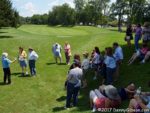
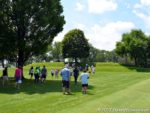
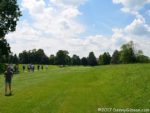 In the first picture we are walking between the parallel mounds that connect the octagon to the circle. The arrangement suggests a walkway. Similar pairs of mounds once connected the area around the octagon with other geometric figures in the complex and possibly with points much farther away. In the second picture we are approaching Observatory Mound and in the third most of the group is arrayed on the mound’s side listening to the guide. The purpose of Observatory Mound is one of the many mysteries associated with the structures. It may have actually been built as something of an observatory. The northernmost rising of the moon can be viewed from it through the circle, octagon, and connecting mounds. It looks as if there was once another opening into the circle at Observatory Mound so it might have been built to close the entrance. The truth is that no one knows and likely never will.
In the first picture we are walking between the parallel mounds that connect the octagon to the circle. The arrangement suggests a walkway. Similar pairs of mounds once connected the area around the octagon with other geometric figures in the complex and possibly with points much farther away. In the second picture we are approaching Observatory Mound and in the third most of the group is arrayed on the mound’s side listening to the guide. The purpose of Observatory Mound is one of the many mysteries associated with the structures. It may have actually been built as something of an observatory. The northernmost rising of the moon can be viewed from it through the circle, octagon, and connecting mounds. It looks as if there was once another opening into the circle at Observatory Mound so it might have been built to close the entrance. The truth is that no one knows and likely never will.
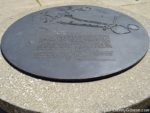
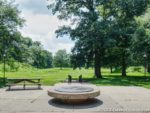
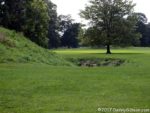 The cluster’s only other surviving enclosure, Great Circle Mound, lies roughly a mile from Octagon Mound. It is also owned by the state and it isn’t leased to a country club or anyone else. It can be visited at any time. These photos were taken near the small museum that stands near the entrance to the circle. The entrance can be seen in the second photo. A large ditch runs along the inside of the circular mound. Much of the material making up the mound was taken from the ditch during construction but there is also evidence that the ditch held water once the structure was completed. Why is just another of the complex’s mysteries.
The cluster’s only other surviving enclosure, Great Circle Mound, lies roughly a mile from Octagon Mound. It is also owned by the state and it isn’t leased to a country club or anyone else. It can be visited at any time. These photos were taken near the small museum that stands near the entrance to the circle. The entrance can be seen in the second photo. A large ditch runs along the inside of the circular mound. Much of the material making up the mound was taken from the ditch during construction but there is also evidence that the ditch held water once the structure was completed. Why is just another of the complex’s mysteries.
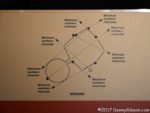 The Newark Earthworks contain no solar alignments but there are a number of lunar alignments. This fact adds to the mystery since predicting the moon’s movements is a tougher job than predicting those of the sun and their role in daily life is much smaller. The picture of lunar alignments was taken inside the museum. The Ancient Ohio Trail website offers excellent information on the Newark Earthworks as well as other Ohio sites.
The Newark Earthworks contain no solar alignments but there are a number of lunar alignments. This fact adds to the mystery since predicting the moon’s movements is a tougher job than predicting those of the sun and their role in daily life is much smaller. The picture of lunar alignments was taken inside the museum. The Ancient Ohio Trail website offers excellent information on the Newark Earthworks as well as other Ohio sites.

Pingback: There Goes the Sun | Denny G's Road Trips Blog